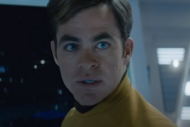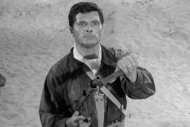Create a free profile to get unlimited access to exclusive videos, sweepstakes, and more!
Star Trek's Ron Moore reveals how he pulled a ‘Game of Thrones’ with a classic Klingon 'TNG' episode

Three decades ago, on June 17, 1991, Star Trek: The Next Generation made TV history.
“Redemption,” TNG’s epic Season 4 finale and 100th episode, marked the first time a Trek TV show had ever achieved that broadcast milestone. The two-parter cliffhanger also created a seismic narrative shift in the Star Trek universe by lighting the fuse on a Klingon Civil War. The impending battle would force Worf (Michael Dorn) to make a choice: Stay out of the conflict and on the Enterprise, or resign and join his people in a fight to protect the Empire from the villainous Duras sisters’ power grab. (Spoiler: Worf trades in his Starfleet uniform for a post aboard a Klingon Bird-of-prey). The consequences of Worf’s decision, along with the fallout for the fate of the Klingon homeworld, would impact the next three decades of Star Trek.
Just in time for the episode’s 30th anniversary, writer Ronald D. Moore talked with SYFY WIRE about the making of this landmark episode, and what it was like to be “the Klingon Guy” responsible for doing some Game of Thrones-esque world building in the Final Frontier.
With “Redemption” turning 30, it’s well-known that you were the “go-to” guy for Next Gen’s Klingon episodes. What is it about Worf and the Klingons as characters that hooked you?
At the beginning, Worf was the most “alien” of characters on the main bridge. You know, Data wants desperately to be human, and Worf doesn’t. And I was fascinated about that aspect of Worf, in that it was similar, sort of, to Spock on The Original Series. Worf is an alien among humans who is a part of their stories, but he can look at all of them from a different point of view. He’s also from another culture that is fascinating — and is in opposition to [humanity] in many ways. It was fun to keep finding more things about him, and about the Klingons, and Worf’s place in that world — but mostly about them as a people. Their history, what their belief systems were, and I just really got into that aspect of fleshing out their story. Again, it was a type of world-building, which is something now that I really enjoy and love, building a culture and society like that. I didn’t set out to do it, but it was world-building. So Worf was my way into that.
You found your way into him with your first TNG spec script.
Right. It started with my first Star Trek episode, “The Bonding.” And through Worf, you discover there’s a ritual we’ve never heard of, and it comes out after a tragedy with an officer that Worf, unfortunately, found himself at the center of. And once we got into the whole “Worf Saga,” when we did “Sins of the Father,” you go to the Klingon homeworld for the first time ever in Trek. It became a rich place to mine — how does it work? What’s it like on their planet? What’s the Klingon High Council like, the traditions and customs? What is taboo here? What’s fun here? It just got more and more interesting for me, so they just started giving me the Klingon shows and I became “the Klingon guy.”
As “the Klingon Guy,” the events of “Redemption” have had a ripple effect on the last 30 years of Trek.
Which I did not really expect. Writing them was always fun for me. I was always sort of tickled to do another one. I’d say “it would be fun to do another one” or “hey, let’s do this [idea]” — there was always a Klingon story coming down the pipe.
So is it a bit surreal for you to know that this episode has become such a load-bearing column for the franchise?
It is kind of funny, yeah. It’s interesting because, when I started at Star Trek, the Klingons were already part and parcel of the franchise. But when you really broke it down, you didn’t know that much about them. ‘Cause there were only a handful of episodes of The Original Series that focused on them, and they make a cameo appearance, basically, in Star Trek: The Motion Picture. And they were the villains in Star Trek III: The Search for Spock. At that time, they were just kind of “the bad guys” of Star Trek. And you never really learn that much about them.
So, with “Redemption” — and before that, with “Sins of the Father” and “Reunion” — was it a mandate on TNG at the time to flesh them out? To make them more than just “bad guys”?
Not really. What happened was, when I was on Next Gen, it was at the point where [the late showrunner] Michael Piller — on my first week — because he knew I was a fan, and he was new to the show and Trek and was trying to get his feet under him, he said: “Just write me a memo on who the f***ing Klingons are.” So I was like: “Okay! I’m going to write you a memo on who the Klingons are.”
What were some of your inspirations for pulling a George R.R. Martin-level world-building with this Klingon memo?
It was informed by Star Trek novels, especially John Ford’s The Final Reflection. A good book, and it really influenced my thinking on how I thought about the Klingons. But it is interesting now that I’m the guy who “made” the Klingon Empire. I’m “the Margaret Meade of the Klingon Empire,” as the writers used to say. Even when I was there, it wasn’t something I was consciously trying to do so it’s ironic that it’s part of my legacy as a Trek writer.
So after building that world, was it by design to use the “Redemption” two-parter to break it up with the threat of Klingon Civil War?
Oh yeah, definitely. It was like: “Okay, now let’s just get into it.” At that point in the series, we were at a place where we could really mess with it. Give them a civil war, and let’s really get into how the power struggles with leadership would really work. And explore the great Klingon [family] houses, and the great dynasties and histories. Especially the rules of the planet and how they conduct warfare. I loved writing that two-parter, it was just really fun to go off into that world.
How close are the final episodes to your original outlines for them?
It was over 30 years ago now, but I think it was fairly close. I remember that the original plan for “Redemption” was for it to be the cliffhanger that ended Season 3, instead of “Best of Both Worlds”. But obviously we delayed it a year. I remember Gene [Roddenberry] — he was not on board with it, originally.
Really? Why? Because of the storyline?
Yeah, it was — at the time, Gene had very specific parameters for how he saw this future. And, as you know, there was no real conflict among the main characters on the show, so the majority of the drama came from outside forces bringing that conflict to our characters. So, even though it was with the Klingons, this was the first time we — the first time that Trek, really — ever did a big war story like this. And Gene wasn't a big fan of going in that direction, and he disliked the idea of centering it on Worf.
Because he didn’t see Worf as a main character or —
He didn’t really see Worf as a primary character, no. The show was about Picard. He was the Captain. And this was going to be the series’ 100th episode on top of it. So, we had to fight somewhat to get past that and get the episode going.
And once the episode got going, I know TNG writers weren’t usually on set for production of their episodes, but were you able to visit at all?
I was, actually. If I recall correctly, I was there when then-President Ronald Reagan came by to visit the set. And Gene was there, and he had a cane at the time and he dropped it. And Reagan, he picked it up for him.
This episode famously introduces the Klingon Duras sisters, who you would use later in your feature script for Star Trek: Generations.
They are great characters; these big, Shakespearean characters you could really take some big swings with. I really enjoyed writing them. But I didn’t really create them. I wrote them, but I believe Michael was the one who initially came up with the idea of having these two sisters be the foil and the people pulling the strings behind this Klingon power grab. I came up with Sela, Denise Crosby’s character. We set that reveal up [at the end of “Redemption, Part I”] in the Season 4 episode with Geordi and the Klingons, “The Mind’s Eye.” We primed her there as this shadowy figure in some sort of Manchurian Candidate-y conspiracy.
Rewatching the episode for the 30th anniversary, it really feels like Game of Thrones: Klingon Edition.
You know, I never really thought of that before. Yeah, there’s a bit of that. No one was really doing that level of world-building then, especially on a syndicated show at the time like TNG was. Now, everyone wants the next Game of Thrones or something similar with that level of serialized world-building. But, yeah, I guess we were one of the first genre shows to sort of explore that. It was really a fun and interesting time to be, as a fan, helping shape that.
“Redemption, Parts I and II” are available to stream on Netflix, Hulu, Amazon Prime, and Paramount+.



























